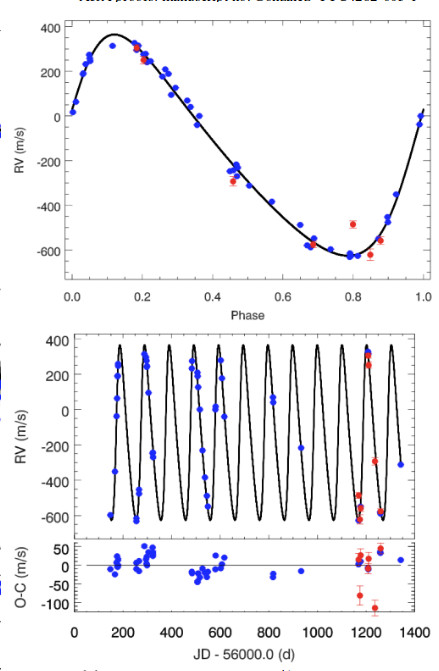HARPS-N and GIANO measurements allow to identify a low mass companion around the star TYC 4282-605-1
Identification of planetary companions of giant stars is made difficult because of the astrophysical noise, that may produce radial velocity variations similar to those induced by a companion.
The goal of this study was to determine the origin of the Doppler periodic
variations in the K giant star TYC 4282-605-1 observed by HARPS-N in the
visible band and verify if they can be due to the presence of a companion
using near IR observations.
In the frame of the programme Global Architecture of Planetary Systems
(GAPS), a total of 48 high resolution spectra were collected with the
high resolution spectrograph HARPS-N at the Telescopio Nazionale Galileo
(TNG). At the same time, an observational campaign was conducted with
the high resolution spectrograph GIANO at the TNG to monitor the NIR radial
velocity, in order to verify whether the near-IR amplitude variations were
comparable with those observed in the visible.
Both optical and NIR radial velocities showed consistent variations with a
period at 101 days and similar amplitude, pointing to the presence of a
companion orbiting the target star. Further analysis allowed to estimate
a mass for the planet included in the range between 10 and 40 Jupiter Masses.
Evolutionary track followed by TYC 4282-605-1, classify the giant as a
10.1 Gyr star (~ 2 times the age of the Sun), being therefore an old giant
star with mass 0.97±0.03 solar masses.
"Because of its proximity to the star, it is likely that the planet will be
swallowed up by the star pretty soon, in astronomical terms," explains
Giuseppina Micela, Director of the INAF - Astronomical Observatory of
Palermo and one of the authors of the discovery. "This may be the reason
why planets so close to red giant stars are so uncommon."
Further studies like this will benefit of the ongoing efforts at the TNG to use HARPS-N and GIANO in a simultaneous way. The project, called GIARPS, will consist in using GIANO and HARPS-N in parallel to take one high resolution spectra in the wavelength range from 0.383 nm to 2.45 nm with two simultaneous exposures.
During the last months the observing capabilities of GIANO have been
improved by replacing the fiber-fed system with a mirror-fed one that
overcomes the typical modal noise of the fibers.
Moreover the forthcoming calibration Iodine absorbing cell will provide a
much more stable wavelength reference than the actual one obtained with
the atmospheric telluric lines.
Once fully operative at the TNG, GIARPS will shed light on the origin of
the radial velocity variations observed in the stars spectra, crucial to
disentangle the star-like components by those produced by the presence of
a planet.
 Caption: GIANO NIR radial velocity with red circles and HARPS-N optical
RVs with blue circles. The best fit Keplerian model obtained from optical
data is plotted with a solid black line. The top panel shows the RV data
in function of the phase. The bottom panel shows the RV as a function of
the time and the residuals information. The NIR radial velocities (in red)
are in excellent agreement with the optical data (in blue)
Caption: GIANO NIR radial velocity with red circles and HARPS-N optical
RVs with blue circles. The best fit Keplerian model obtained from optical
data is plotted with a solid black line. The top panel shows the RV data
in function of the phase. The bottom panel shows the RV as a function of
the time and the residuals information. The NIR radial velocities (in red)
are in excellent agreement with the optical data (in blue)
More information at
Astro-PH
TNG contact: dydat@tng.iac.es

